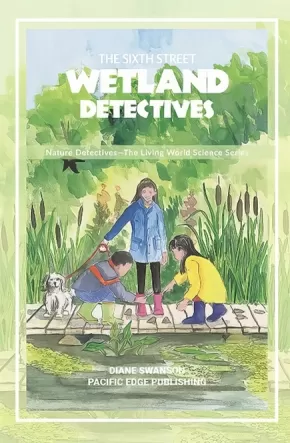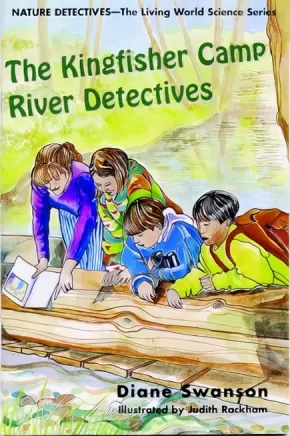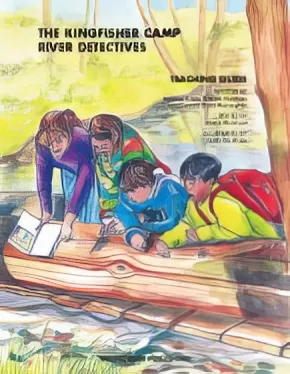The Nature Detective Series
The Nature Detective Series is a set of five books and five activity guides, developed specifically to address learning standards in the BC science curriculum.
Written by award winning BC author, Diane Swanson, the Nature Detectives Series tells the stories of groups of adventurous nature detectives as they discover the life in five different ecosystems; westcoast rainforest, seashore, wetland, grassland and river. These enjoyable books provide primary teachers with a language-based resource from which science and language arts can be extended across the curriculum.
Each book introduces children to one of five fascinating ecosystems. It shows how plants and animals interact and adapt themselves to the forest. It shows how living things depend on non-living things, such as water, light and soil. The book also presents examples of fossil forest life, First Nations' uses of forests and the ways people harm-and help-the forest. By the end of each book, children have a new appreciation for each ecosystem.
Synopsis:
The Gibson Park Grassland Detectives Teacher's Guide provides excellent support materials to meet the national Life Science learning outcomes for the development of skills and the acquisition of knowledge. The guide facilitates the integrative teaching of Language Arts, Science, and Social Studies.
This guide includes:
- activities integrating themes across the curriculum (Language Arts, Social Studies, Math, and Art)
- hands-on activities
- reproducible blackline masters
- suggested assessment strategies and tools
- references and annotated resource list of related titles
- links to appropriate WWW sites
Synopsis:
Join nature detectives Amy, Edward and Jill as they explore the wetlands near town. With their families, who are neighbours on Sixth Street, they make some exciting discoveries:
- Water lilies breathe through pores on the tops of their leaves.
- Duckweed is the world’s smallest flowering plant.
- Cattail colonies make good homes for many animals.
- Water striders walk across water.
- Muskrats build their houses from mud and stems.
The Sixth Street Wetland Detectives introduces readers to nature's wonderful wetlands. It shows how plants and animals interact and adapt to the wetland. It also teaches how living things depend on non-living things, such as water, light and soil.
The book also presents examples of wetland fossils, Indigenous peoples’ uses of wetlands and the ways people harm—and help—wetlands. By the end of the book, Amy, Edward and Jill want to help care for the wetland near their town. They find a way.
Series & Educator Information
The Nature Detectives Series is a set of five books. Each book introduces children to one of five fascinating ecosystems designed to address the grades 2 to 4 learning standards in the BC Science curriculum.
Each book introduces children to one of five fascinating ecosystems. The books show how plants and animals interact and adapt themselves to their environment. They show how living things depend on non-living things, such as water, light, and soil. The books also present examples of fossil life, Indigenous peoples’ uses of plants and animals in each ecosystem, and the ways people harm — and help — ecosystems. By the end of each book, readers will have a new appreciation for an important ecosystem.
Each text includes a glossary, index, and information about:
- the diversity of plants and animals in an ecosystem
- how plants and animals have adapted themselves to their environment
- how plants and animals interact with each other
- the life cycles of specific plants and animals
- fossil records of plants and animals
- the causes and effects of extinction and endangerment of plants and animals
- Indigenous peoples’ uses of plants and animals
Additional Information
46 pp. softcover, full-colour illustrations
Synopsis:
The Kingfisher Camp River Detectives shows how plants and animals interact and adapt themselves to the river. It shows how living things depend on non-living things, such as water, light, sand and gravel. Young children will take delight in discovering that;
Black cottonwood trees thrive in damp riverbanks.
Belted kingfishers dive into rivers after fish.
Quartz in river sandstone is harder than a knife blade.
Bears beat paths to waterfalls to catch salmon.
The book also presents examples of river fossils, First Nations' uses of river life and the ways people harm and help the river.
Educator & Series Information
This book is part of The Nature Detectives Series.
Synopsis:
The Kingfisher Camp River Detectives Teacher's Guide provides excellent support materials to meet the national Life Science learning outcomes for the development of skills and the acquisition of knowledge. The guide facilitates the integrative teaching of Language Arts, Science, and Social Studies.
This guide includes:
- activities integrating themes across the curriculum (Language Arts, Social Studies, Math, and Art)
- hands-on activities
- reproducible blackline masters
- suggested assessment strategies and tools
- references and annotated resource list of related titles
- links to appropriate WWW sites
Synopsis:
The Cedar Club Forest Detectives Teacher's Guide provides excellent support materials to meet the learning standards for the development of skills and the acquisition of knowledge. The guides facilitate the integrative teaching of Language Arts, Science, and Social Studies.
This guide includes:
- activities integrating themes across the curriculum (Language Arts, Social Studies, Math, and Art)
- hands-on activities
- reproducible blackline masters
- suggested assessment strategies and tools
- references and annotated resource list of related titles
- links to appropriate WWW sites
Synopsis:
Join the Gibson Park nature detectives—Lynn, Mike and Christie—as they explore the grasslands near town. With Christie's teenage brother, Tim, they make some exciting discoveries:
• Sagebrush has hairy leaves that protect it from heat and cold.
• Coyotes, hares and burrowing owls use burrows dug by badgers.
• Grasshoppers can jump 20 times their length.
• Meadowlarks build a grass roof over their ground nests.
• Magpies collect shiny things.
The Gibson Park grassland detectives introduces readers to nature's great grasslands. It shows how plants and animals interact and adapt to the grassland. It also teaches how living things depend on non-living things, such as water, light and soil.
The book also presents examples of grassland fossils, Indigenous peoples’ uses of grasslands and the ways people harm—and help—grasslands. By the end of the book, Lynn, Mike and Christie want to help care for the grassland near their town. They find a way.Reviews"These are must-have resources for the classroom and for inspiring the next generation of environmental champions and green leaders!" - Canadian Teacher Magazine
Series & Educator Information
The Nature Detectives Series is a set of five books. Each book introduces children to one of five fascinating ecosystems designed to address the grades 2 to 4 learning standards in the BC Science curriculum.
Each book introduces children to one of five fascinating ecosystems. The books show how plants and animals interact and adapt themselves to their environment. They show how living things depend on non-living things, such as water, light, and soil. The books also present examples of fossil life, Indigenous peoples’ uses of plants and animals in each ecosystem, and the ways people harm — and help — ecosystems. By the end of each book, readers will have a new appreciation for an important ecosystem.
Each text includes a glossary, index, and information about:
- the diversity of plants and animals in an ecosystem
- how plants and animals have adapted themselves to their environment
- how plants and animals interact with each other
- the life cycles of specific plants and animals
- fossil records of plants and animals
- the causes and effects of extinction and endangerment of plants and animals
- Indigenous peoples’ uses of plants and animals
Teacher's Guides for each of the books in this series are also available.
Additional Information
46 pp. softcover, full-colour illustrations











